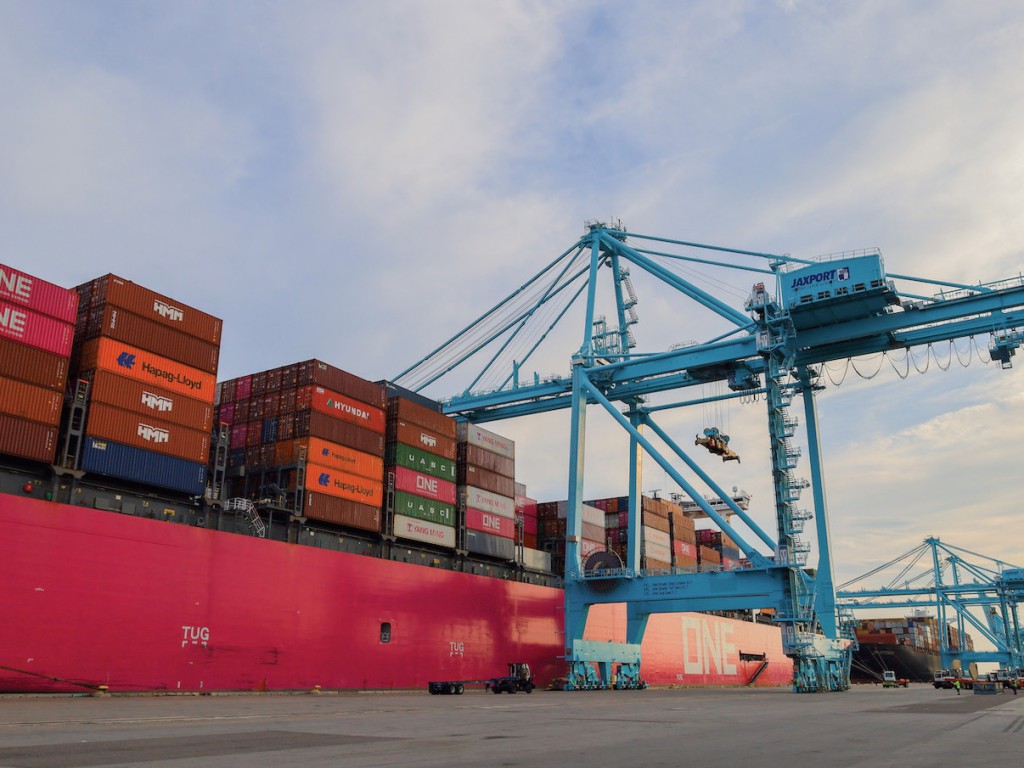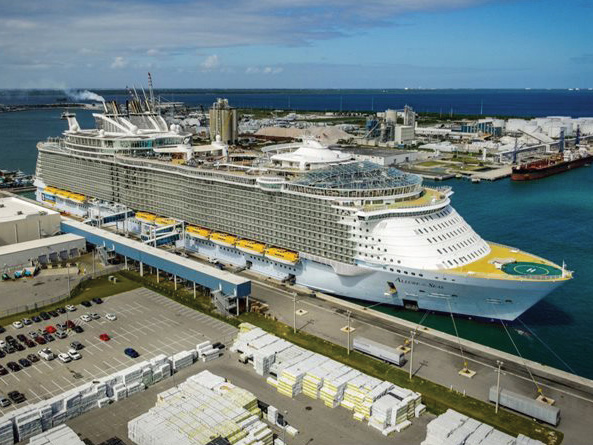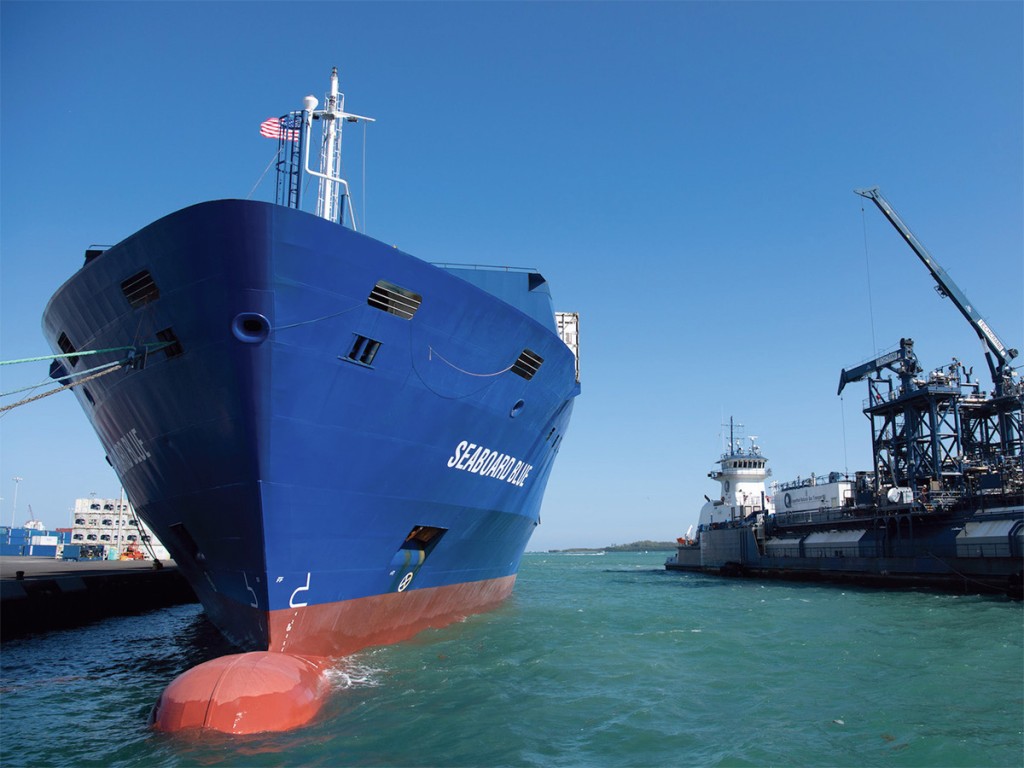The Port of Jacksonville

To say things are humming along at the Port of Jacksonville would be an understatement. The Port of Jacksonville, located in the northeast corner of the State, is Florida’s largest container port, and has been engaged in a methodical improvement of the port’s facilities to position itself for an anticipated increase in freight in the next decade.
Although Jacksonville 1.3 million TEUs in FY2023 is the headliner, the cargo mix is impressive. The Port handled nearly 900,000 tons of breakbulk, almost 2 million tons of bulk, and over 500,000 units of autos in FY 2023. Developing the port facilities to efficiently utilize available land has been an ongoing process. And as was outlined in JAXPORT’s five-year Strategic Master Plan, expanding capacity for breakbulk and bulk products is one of the key strategies.
In late January 2024, JAXPORT inked a long-term, 30-year deal with U.S. marine terminal company Enstructure for the lease and development of 79-acres of waterfront property at JAXPORT’s Talleyrand Marine Terminal.
Enstructure is the parent company of Jacksonville-based Seaonus Stevedoring, a current JAXPORT tenant operating 35-acres of adjacent space at JAXPORT’s Talleyrand terminal. Seaonus has been a JAXPORT tenant for 27 years. Combined with its current acreage, the new agreement will provide Enstructure with a total of 115 acres at the Talleyrand terminal.
Enstructure will begin leasing the new acreage in late 2025 when the current tenant, Southeast Toyota Distributors, relocates to the port’s Blount Island Marine Terminal. The 79-acre Talleyrand property will be a mixed-use facility with the flexibility to move multiple cargo types, including breakbulk, dry bulk, vehicles, and containers. The agreement calls for Enstructure to develop at least 200,000 square feet of new on-terminal warehousing at Talleyrand. The additional warehousing will increase JAXPORT’s on-terminal covered capacity to handle non-containerized cargo such as forest products by 20%. The agreement includes a $136 million lease with JAXPORT over the term of the contract.
In December of 2023 the Port also passed an important developmental milestone. SSA Marine has reached the halfway point in a $72 million project to expand and modernize the SSA Jacksonville Container Terminal. Located at JAXPORT’s Blount Island Marine Terminal, the SSA Jacksonville Container Terminal project is a public-private partnership between the port and SSA Marine.
The phased construction project began in 2022, with the company completing four of the project’s eight phases, including installing upgraded terminal lighting and a redesigned terminal gate system, as well as paving nearly 40-acres with heavy-duty asphalt. Six new outbound truck lanes are also currently under construction and scheduled to open in February 2024, with improvements to the terminal’s six inbound lanes scheduled for completion in late 2024.
Currently, the SSA Jacksonville Container Terminal features newly rebuilt berths and a 47-foot deepwater shipping channel.
Upon completion in 2025, the facility’s upgraded yard will feature 97 acres of newly paved asphalt to accommodate taller stacks of loaded containers, with the capability to further expand the terminal to 120 acres as needed.
In 2025, the facility will be able to accommodate nearly 500,000 TEU annually, a 150% increase over its current throughput. The increased capacity will bring JAXPORT’s total TEU capability across all terminals to more than two million TEUs annually, approximately double its current throughput.
Port Canaveral

The Port of Canaveral is known mostly for its cruise ship calls — it is arguably the busiest cruise port in the United States, (arguably as it flip flops for the title with PortMiami) and was voted the Best US Cruise Homeport of 2023.
But Port Canaveral is more than a cruise port. In July of 2023 the Port celebrated a landmark event with the arrival of the Saga Welco vessel, the Saga Morus, the first ship to dock and unload at the Canaveral’s renovated North Cargo Berth 3 (NCB3). The 650 foot break bulk vessel carried approximately 11,000 cubic meters of high-quality OSB plywood from Latvia, equivalent to 4,189 bundles for Kronospan USA, the Alabama-based manufacturer.
Mike Noyes, President of Ambassador Services International (ASI), a terminal operator at Port Canaveral, emphasized the significance of this achievement, stating, “The activation of this new berth is a monumental leap forward for cargo operations at Port Canaveral, benefiting the entire maritime community and signaling a promising future.” Under the agreed terms with Kronospan, ASI will receive an annual supply of 64,000 cubic meters, with six ship arrivals expected each year.
The official ribbon-cutting opening of Port Canaveral’s NCB3 took place on June 29, 2023, marking the successful compeletion of the $48 million Port Canaveral Cargo Berth Rehabilitation and Modernization Project.
In July of 2023, Port Canaveral began the next phase of the $37 million berth modernization project, which entailed the demolition and subsequent rebuilding of North Cargo Berth 4 (NCB4). The project will add an additional 880-feet of modern bulkhead adjacent to the newly completed NCB3. NCB4 has a completion date in mid to late 2024. Back in November 2023, Capt. John Murray, Port Canaveral CEO, presented an overview of the Port’s strong performance in Fiscal Year 2023 and expressed a positive outlook for the upcoming FY 2024 during his annual “State of the Port” address. Capt. Murray noted that in FY 2023, Port Canaveral set an all-time high with 6.8 million cruise passengers, homeporting 13 ships, and receiving 906 ship calls. Additionally, the Port’s operating revenue reached a record-breaking $191 million, including a record-breaking $158 million from cruise operation. Capt. Murray emphasized the Port’s success, stating, “This is a significant jump from last year when we finished the year at $127 million. It has been quite a year at this Port.”
The cargo side of the Port’s business also did well in FY 2023, handling 3.7 million tons in petroleum, 1.9 million tons in aggregates, nearly a million tons in lumber, and an additional 533,000 tons of general products, totaling just under 7 million tons.
In 2024, Port Canaveral is scheduled to homeport 13 cruise ships, hosting 7.3 million passengers, and anticipating 913 ship calls.
With both cargo and cruise ship calls expected to climb Canaveral plans on investing $182 million in capital improvements for FY 2024, part of the $500 million 5-year Capital Improvement Plan.
Port Everglades
In January 2024, the Broward County Commission approved the appointment of Glenn A. Wiltshire as Acting Director of Broward County’s Port Everglades Department. Wiltshire, the current Deputy Port Director, will take over from former CEO and Port Director Jonathan Daniels who in February 2024, became the Executive Director of Maryland Port Administration and the Port of Baltimore. According to Broward County Administrator Monica Cepero, “A national recruitment has been initiated for the next CEO and Port Director, adding “Wiltshire has committed to continuing to serve the port in his permanent capacity as Deputy Port Director after the selection of a new Port Director has been made.”
Back in July of 2023, Port Everglades, which handles in excess of a million TEUs annually, received notice that Port Everglades was ranked 89th out 348 container ports worldwide for operational performance in the World Bank 2023 “The Container Port Performance Index 2022.” This represented a significant improvement on the port’s 2021 ranking at 116. In 2022 Port Everglades ranked 5th regionally, among the US and Canadian ports, up from number 11. And also ranked as the second highest performing Florida seaport behind JAXPORT.
The Port was also awarded a $32 million infrastructure grant to mitigate environmental threats from flooding and sea level rise and ensure continued access for marine vessels. This grant is part of more than $275 million for resilience projects issued by the Florida Department of Environmental Protection.
The Port Everglades will use the Resilient Florida Infrastructure Grant to replace bulkheads in the northern part of the Port, which will assist in reducing the impacts of climate change. In addition to replacing the aging bulkheads, there is a future opportunity to raise the bulkhead height. The bulkheads will be designed based on a projection of 4.36 feet in sea level rise by 2095. The estimate comes from U.S. Army Corps of Engineers’ High Scenario Sea Level Rise established by the Intergovernmental Panel on Climate Change Fifth Assessment Report. Additionally, the Port will replace the north entrance channel bulkhead, which will support the continued safe navigation of the waterway for all marine traffic.
Perhaps the biggest news for the Port was the decision by Mediterranean Shipping Company (MSC) to relocate the Santana service from Miami to Port Everglades Terminal (PET). Allen Clifford, MSC›s Executive Vice-President - North America said of the port shift, “The move to PET was a strategic decision to optimize our operations and meet the growing demands of our clients.” Adding, “This relocation positions us to seize opportunities and expand our service offerings, solidifying our commitment to excellence in the maritime industry.”
PET has undergone a remarkable transformation under the management of Terminal Investment Limited (TIL). With a dedicated team at the helm, significant enhancements have been made in terminal operations, leading to smoother cargo handling processes and overall efficiency improvements.
Part of the transformation at PET was the addition of new equipment. In December 2023 PET and Orange EV began a trial run of four electric yard trucks. The HUSK-e® Class 8 trucks are used to move trailers and cargo containers within the port.
Kurt Neutgens, President and Chief Technology Officer of Orange EV said, “As an industry pioneer, Orange EV initiated the electric terminal truck revolution in 2015, setting new standards for performance, reliability, and sustainability in heavy-duty trucks,”
PortMiami

In early January 2024, PortMiami dubbed the “Cruise Capital of the World”, and as befits the moniker, the Port welcomed Royal Caribbean’s Icon of the Seas whose own moniker is “The World’s Largest Cruise Ship”. The nearly 1,200 foot long Icon of the Seas can accommodate a staggering 7,600 passengers — or potential customers for a port of call like Miami.
Miami-Dade County Mayor Daniella Levine Cava alluded to that fact in her welcoming remarks, “Miami-Dade County is thrilled by the arrival of Icon of the Seas, which will attract cruise passengers from around the world and positively impact our economy.”
And PortMiami saw a few cruise ships in FY 2023 and is expecting more in 2024.
PortMiami with 7,299,294 passengers calling reached a record-breaking year in cruise activity for FY 2023. The Port experienced a 6.97% increase in cruise passenger totals compared to its previous record of 6,823,816 passengers in FY 2019, prior to the pandemic.
But there was more to the Icon of the Seas first call than the size of the ship and the passengers arriving in Miami. The Icon of the Seas is Royal Caribbean’s first Icon Class ship and first ship with fuel cell technology and powered by liquefied natural gas (LNG). The dual-fuel engines will work alongside a lineup of energy efficiency initiatives and industry-leading environmental programs on board, like the first waste-to-energy plant at sea and shore power connection.
Upon completion in 2024, shore power capability will be available at five PortMiami cruise terminals. Shore power allows a cruise ship to turn off their primary engines while docked, resulting in reduced air emissions. However, the shore power is just part of the environmental efforts. In July 2023 the U.S. Department of Transportation awarded PortMiami a $5 million Rebuilding American Infrastructure with Sustainability and Equity (RAISE) grant to complete portions of its Master Plan. The RAISE grant will assist in funding PortMiami’s planning and design studies for carbon neutralization of on-port operations and the development of an inland cargo center, among other projects.
The planning project will include both on-port and off-port planning and design for an optimized sequence of services from seaport to and from inland port(s). The project will also have design studies to achieve carbon neutralization of on-port operations, development of an inland cargo center to handle 50% more cargo volume, and deploy innovative technologies, including radio frequency identification and the electrification of supply chain movements, which will reduce the use of fossil fuel.
Miami has also deployed LNG bunkers. In March the MV Seaboard Blue, operated by Seaboard Marine, was bunkered at PortMiami using liquified natural gas (LNG) as a fuel. Shell, using its Q4000 bunker barge, filled the Seaboard Blue with LNG prior to its inaugural southbound sailing to Honduras and Guatemala. The 1,000 TEU vessel, was retrofitted in 2017 with the capability of running on both LNG and diesel fuel. The vessel was the world’s first container ship converted from conventional diesel propulsion to LNG. This Sunday, for the first time, the Seaboard Blue called PortMiami home and joined the Seaboard Marine’s North Central America service.
Miami in May of 2023 also added a new service to its portfolio of boxship callers. Zim’s Colibri Xpress Service to South America. This service is a premium line from South America West Coast to the United States East Coast. Zim will deploy six 1,700 TEU vessels with increased capacity for refrigerated cargo.
Nissim Yochai, EVP, ZIM US President & Head of Latin America Business Unit, said: “Our new ZIM Colibri Express (ZCX) line was designed recognizing Miami as a central port serving the Latin America trade. ZCX service is focusing on agility, efficiency, and reliability, with special emphasis on refrigerated cargo. The service will operate on a line calling on San Antonio (Chile), Callao (Peru), Guayaquil (Ecuador), Cartagena (Colombia), Kingston (Jamaica), Philadelphia – Miami, Kingston (Jamaica) – Buenaventura (Colombia), Guayaquil (Ecuador) – Callao (Peru), San Antonio (Chile).





